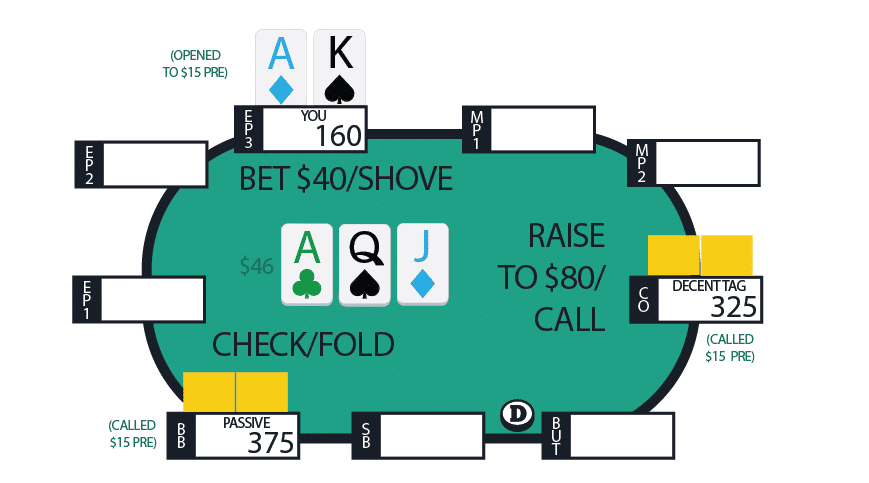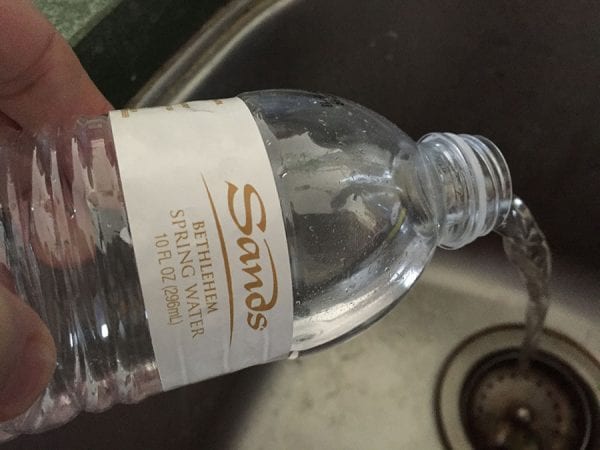Strategy in Action is a monthly feature recorded & written by a ‘recreational grinder’ who’s studying our training material in order to consistently beat $1/$2. Read the introduction here, or check out what happened in the last episode, Poker Notes. The video rundown is a new thing:
At $1/$2 NL, pre-flop open raises should be something like $12 +$2 per limper behind.
Like “never limp”, “don’t pay people off”, and “plan ahead”, this bet sizing rule is a rule of thumb. There are times to limp, to hero call, to act on gut instinct. Those are exceptions, not rules.
The $12 +$2 nugget of wisdom was delivered to be by Red Chip Poker coach Doug Hull during my first-ever coaching session. In the trouble hands we analyzed from our last episode, he noticed a lack of consistent open size prelop, and woefully anemic bets.
Coach’s Conclusion
Taking stock of my game, Hull demonstrated in Flopzilla how certain ranges hit certain flops, and why I was needlessly worried that raising big would telegraph the strength of my hand or make me vulnerable in some other way. I remember leaving the coaching session with a distinct mathematical intuition that I need to be less afraid of my opponents drawing out on me, and more focused on generating value and isolating passive players with big preflop bets.
I went to the casino with a commitment to make consistently large bet sizes preflop. I probably should have expected this to introduce a little more variance in my game. I was heretofore playing fairly conservatively with a small bankroll for $1/$2 (about $2500).
But as it turns out, the greater variance in consistently bet sizing to play bigger pots was the least of my worries.
Life Tilt
Everyone, even non-poker players, experiences life tilt from time to time. Life has a tendency to throw a lot at you all at once, and leave you scrambling to manage the chaos.
The morning before my roughly 5-hour casino round-trip was classic life tilt: Waking up with a splitting headache. Urgent work matters intruded. There were still things to take care of around the house. I remember thinking several times, “Am I really going to go play poker today?”
The problem? I thought I was doing the right thing by being stubborn and persevering through the challenges and discomfort. Like many of you, it’s really hard for me to make time to go play. I pressed on with my quixotic journey.
Whee! Down the Tilt Slide
The scene at the casino was madness, tourists (in Pennsylvania!) packed shoulder-to-shoulder. Lines for the under-maintenance bathrooms snaked out onto the casino floor. The line for most food vendor and restaurants was pushing 45 minutes. It was going to take an hour to eat.
Already titled and titling further, I continued my doomed crusade and sat down to play some $1/$2 NL. A brand new table opened and I was seated with a bunch of people who seemed to know what they were doing. My confidence has been boosted of late from the Spotting Live Poker Pros episode of the Red Chip Poker podcast, which advocates going head-on to meet the challenge of highly skilled opponents. But this was far from the soft tables I was used to, and the tilt ratchet cinched a little tighter.
The session started out well enough. On one hand the big bet sizing worked out — I raised AsQc in middle position to $15 after one limper, got called in 3 spots (limper folded). Flop is QJ7 w/two spades (I have the A of spades), I c-bet $40, get called in one spot, turn is a brick and I bet $100 (probably should have shoved?), opponent folds.
After that, I picked up pocket tens in middle/late position twice, raised big preflop into a few limpers, still got 3-4 callers, two overcards and several draws flopped, and I check/folded.
I had been making a point to be a little more careful on boards that are likely to hit other players, and TT on a KQ8 flop with two hearts did not feel as strong as it would have on J94, which would have seen me c-bet. I had kind of downshifted from c-betting 90% of the time to 70%.
I noticed that after I started opening big, other players started doing it too. At least half the table had switched from their default wimp opens of $8 to three red chips. I could see why action-hungry coach Hull would love this — as the best poker player at the table, he gets everyone to play a bigger game and put more of their stacks at risk.
It’s important to point out that this clarity of analysis is only in 20/20 hindsight. In the moment, all I could think of was, “How am I going to eat and still keep my seat, and where can I buy Advil?”
The $300 Life Tilt Lesson
Now, I’ve paid some hefty poker lesson fees before… The $300 “don’t call down three streets with a K-high flush” lesson… The $400 “always notice if the board pairs on the river” lesson… The $600 “don’t drink two bottles of wine at the table, get escorted out by security, and wake up in the corner of a low-budget motel in Atlantic City with a ticket for a tournament that started 5 hours ago” lesson.
I thought these kinds of expensive lessons were behind me. Then I paid the $300 life tilt lesson.
It’s totally embarrassing and it looks like this after I raise to $15 with AK and get called in two spots:

At this point, you are all screaming, “Fold your hand, no way you are good here with the shove! This flop is smashing his range and the min-raise is baiting you for a shove.” You might still be crying at the c-bet lead on the flop. I didn’t stop to think how pot-committed I already was, and how check/calling the flop might give me room to fold the turn.
As I pushed that stack out there, I heard those exact thoughts echoing in my head. Before any cards were flipped, I knew I had tilt-shipped the last of my stack. I was a huge dog to win this hand. In a way, I was sabotaging my own session to bypass my stubborn will to play poker when I should have stayed home. Nice move, unconscious mind! Good looking out. Next time can it cost less?
I knew I lost the second I started pushing my stack in. Now that the river had delivered no hope, I flipped top pair, top kicker, and my opponent showed a set of queens that I barely glimpsed. I was surprised he flatted pre with QQ, but it ended up being the right move to get all my money. I was up out of that chair instantly, walking to the exit. Firing the second bullet in my pocket was never a consideration. The lesson was learned.
Plan B
Plan B was something I concocted when I first started Strategy in Action, but I haven’t mentioned it or needed it until this episode.
If I hadn’t embarrassed myself enough, I’m going to admit to you that I only just now saw Star Wars: The Force Awakens. It was my Plan B all along. I ran so good and played so well I never needed the Plan B.
It’s a miracle, but somehow, over the months, I managed to avoid every spoiler, and I was able to finally catch up on this critical piece of pop culture history. Any thought of poker losses evaporated and I felt like I was 8 years old again.
I recommend having a plan B to get your entertainment value out of your poker time if it gets interrupted by life tilt and/or chip loss. Sometimes all you need is a distraction to avoid stewing in the foul odors of defeat.

How my session went.
Forging Ahead
On the one hand, this was kind of a downer of an episode. But let’s dump some sugar on these lemons and look at the bright side. I’m never losing $300 to life tilt again. Ensuring that will be easy.
One of the biggest new appreciations this loss has given me is for bankroll sizing. I’ve mentioned it much in the past because I am under-rolled for these stakes. But it took the loss of a buy in to appreciate the fact that I’m really taking a shot every time I play $1/$2. A few bad sessions and the bankroll goes bye-bye.
I am not shying away from taking shots. There’s an epic thread in the Red Chip Poker forums right now about, among other things, to what extent is poker “all about the money”, and the importance of taking shots regularly. I think seeing a non-reg poker player take shots is more entertaining than listening about my 25NL grind online.
At the same time, the thought is creeping in that I need to find a way to get some volume online at stakes that are kinder to my bankroll. And it’s not just the stakes — the volume is going to be super-important because…
What’s Next
I’ll be in Vegas for the Red Chip Poker 2nd Annual Meetup at the World Series of Poker 2016. I will be playing with coaches and other high-level players on a slim bankroll, and putting in hours in the cash games whenever I can. It essentially puts my entire bankroll at stake. This is for real.
I simply need to put in volume between now and then. I have no choice but to look into an online playing arrangement, however headache-inducing that may be. It’s the only way I’m going to get in the volume I need to hold my own in Vegas.
Volume is going to fuel my study by giving me so many more hands to analyze. I’ll continue to watch training videos to spot-correct my play as I identify leaks and trouble areas. But my plan is simple: Play lots of hands, analyze the ones I have trouble with, post the hardest ones to the forum, help others with advice, and study the trouble spots.
I’ve already been writing too long, I have a lot to work on, including figuring out how to play real money online poker in New York all over again (hit me up at @zacshaw on Twitter if you have any advice.)
See you again in May!

Hey. My name is Eric. Also from New York kind of in same boat. I live almost two hours from Sands (main casino) and am trying to build a poker bankroll from scratch. Currently sitting on about 2k after a terrible session last Sunday in which i dropped two buy ins. Really Bad beat followed by tilt and mental game errors. Was on a hot streak and it definitely humbled me. On the way home i also thought it would make more sense to focus on online play where i could leverage a fraction of the money at risk and also become a lot better player. I have been playing on and off on America Card Room for about a year. Decent action and they also offer rake-back. I decided to put a lot more volume into grinding 10 and 25NL. Good luck in whatever decision you make. Enjoy reading these updates.
Thanks for the comment, Eric.
It’s spooky how similar your situation is to mine. Curious to hear how putting in more online volume works out for you.
If you have any insider tips on getting started w/ACR, please let me know. As a NY player it seems like the only good option. I hope to be playing 10NL & 25NL on ACR by this time next week.
GL!
Yea very funny how simlar our situations are. I have read all parts of this series and i can absolutley relate. Acr is really the only option for NY players. I am grinding from 5nl and trying to climb up 6 max cash using strict bankroll managment. I went on a downswing trying to play 25NL without proper bankroll. But the micro stakes are pretty soft. Math is a weakness of my game and playing online is a way to help practice. I also find that reviewing hand histories post session can help decision making even in live play, Such as c betting diffrent board textures and experimenting with bet sizes. ACR also offers rakeback which helps grow the bankroll If you have any questions setting up let me know. Ill also shoot you a follow on twitter. GL man.
We seem to miss each other at the Sands. You are there the weeks I am not.
I too was running well at the Sands. I’m embarrassed to tell you how much…. but, I go there every week willing to lose %10 of my bankroll.
If I lose it all, then I need to start over somehow.
Two weeks ago I was up 10% of my bankroll after the first night … and down 5% of my bankroll after the 3rd night. Mostly this was because I tried to reproduce the glory of the first night where I bluffed at the right time and called down at the right time and bluffed and bet more than I ever had before. I felt completely in control of the table when ever I was in a hand. I am a bit of a “triumph junkie” and that first night was devastating to everyone at my table and very fun for me.
It was my first LAG success. And I wanted it again. But good LAGs need to read the other players; I had a good read on my opponents the first night and all the wrong reads the next two. So I suffered a $1350 reversal.
The funny thing is that it didn’t hurt, and that is a little bit of a problem for me. My strengths are my weaknesses.
What hurt me most is that I didn’t feel concentrated the next two days. I didn’t want to notice my lack of concentration and focus. I have “focus warm-ups” that I have been doing since I was a kid, before tests, before chess games, before speeches, before all competitive events. If the focus warm-ups don’t work and I can wait I will wait. The warm-ups usually work as a “cue” or “trigger”. I suggest finding your own.
For some reason I forgot to do my warm-ups and that hurt. Then I just pushed my usual 6 to 8 hour sessions to 12 hours. This is my form of tilt — not quitting. I usually set the timer on my phone for 2:15 hours (break 10 to 10 min), 1:45 (break) 1:30 (break 5 to 15 minutes), 1:30 (decide to quit or play another 2 hours.) I didn’t do this. This is a sure sign for me that I am pushing myself too much.
I don’t go on tilt in the usual ways: I don’t get angry; I don’t feel bad beats are “unfair”; I don’t think that I deserve to win. I simply get numb to losses. I lose my “feel” for the table, my ability to see the other players’ point of view, and finally my ability to simply count the loses and the frequencies. I become numb to the money. My problem is the opposite of some. I lose my desire to win. And not caring for the money only makes it worse.
The hunger and desire to win is what keeps me going. When I lose that because of tiredness or lack of concentration it is very dangerous. I am liable to loose very quickly in that case, because quite frankly at the table, it really is only chips.
I joked in the thread you referenced that sitting down at the poker table in the first place is a kind of “life tilt.” I don’t think anyone took me seriously. But truly, look at going to the poker table as “life tilt;” think of it this way half-seriously and half-ironically.
There is so much that we do in our lives that is like this, negative-EV, built-in trade-offs, external costs, opportunity costs. Driving a car for instance is one of the riskiest things most people do but they don’t approach this decision as if it were a decision. They just do it. Risking $300 feels riskier than driving to the casino, but in many ways the biggest decisions you made that day was to drive to the casino and then to drive to the movie theater. For a day or a week approach all of your decisions with the same kind of mindfulness you try to bring to going to the poker table. Don’t paralyze yourself, but try being aware of when you actually make a decision.
This doesn’t help your poker, directly, but it might give you perspective on “life tilt” and how to make your decision about driving to the casino or the movie theater. (I expect an LOL here.)
Comment appreciated, sentiment shared.
It’s said poker is an information game. Our informational awareness is so often focused purely on external factors. In poker, inward informational awareness is what separates winners from losers in the long-term.
Glad to hear I’m not the only one throwing 10% of their bankroll at the Sands $1/$2 tables. I think there are worse places to do it.